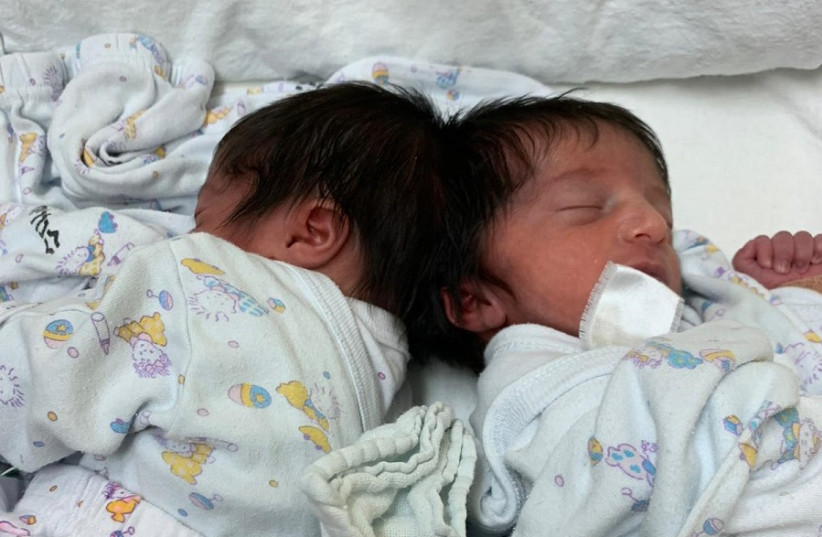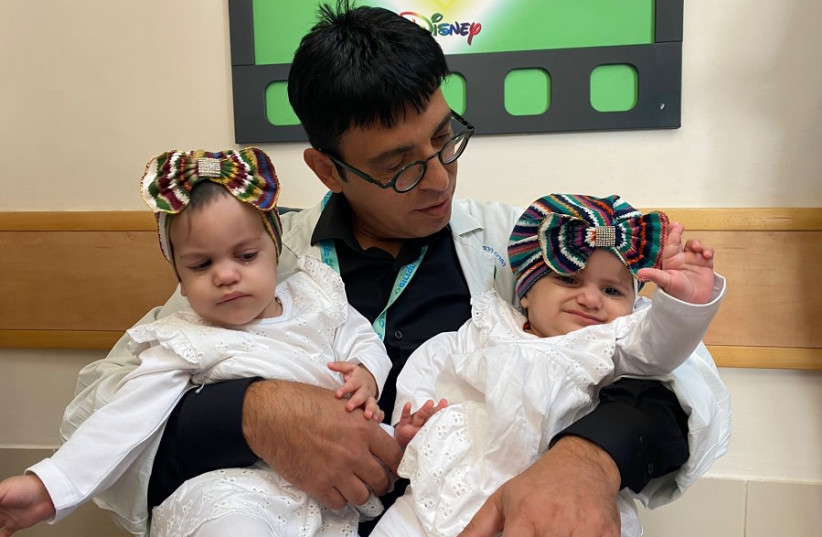From a medical perspective, Israel is considered among the world’s most advanced countries. In this context, the Soroka University Medical Center of the Clalit Group is one of Israel’s leading medical institutions. It is also an internationally renowned innovative medical institution. In fact, Soroka became one of the few medical institutions in the world to separate a pair of twins conjoined in the head.
Prenatal preparation
The process began when the mother was four months pregnant. She had been treated from the start at the Saban Birth and Maternity Center at Soroka, and the medical staff soon realized that they were dealing with the very rare occurrence of twins conjoined in the head.
Twin that are conjoined in the head (craniopagus twins) are very rare. On average, such twins are born once in every 20 million births . Consequently, operations to separate such twins are extremely rare, and the documented information is nearly nonexistent. In all of recorded medical history, some 50 such operations have been performed, and only 20 have been successful.
Once it was decided that the operation would be performed, the pregnant mother was kept under constant medical surveillance. The preparation for the complex birth included medical teams from Soroka, which included staff from the Saban Birth and Maternity Center and the Saban Pediatric Center. This involved neonatologists, anesthesiologists, imaging specialists, teams from the Surgical Division and operating rooms, pharmacists, and laboratory and service teams.

‘A complicated situation’
Prof. Alex Zlotnik, chairman of the Division of Anesthesia and Intensive Care and head of the anesthesiologist team, had a very hard task.
He says, “We were in a complicated situation. We had to deal with two different patients, and we had to be ready for every eventuality.”
The operation was preceded by a preliminary stage of surgery during which an expander was inserted under the scalp to create excess skin to be used to close and cover the area following the separation. This procedure was performed in April 2021 with the twins still conjoined.
The separation procedure
The separation surgery lasted more than 12 hours. Dozens of staff members from Soroka took part in the many preparations for the surgery and in its execution. The multidisciplinary team used three-dimensional and virtual reality models that simulated in the most accurate way possible the complexity of the connections of the twins’ blood vessels, meninges, skull bones, and skin. This made possible dozens of practice runs and simulations of all the complex stages of the surgery.
The entire procedure was presided over by Tal Hayun, the operating room head nurse. She says, “It was an exciting experience. All the nursing staff collaborated in full, and the result was a great success.”
After the separation of the blood vessels, the bones were separated. At that point, the team members split into two teams. They worked in two separate operating rooms, performing reconstruction of the skulls and scalps of each of the twin girls.
In this context, Prof. Eldad Silberstein, head of the Plastic Surgery and Reconstruction Department and head of the plastic surgery team says, “The plastic surgery was an important element in the operation. You must bear in mind that the twins were connected in the back of their heads. There was no tissue in that part of their bodies, so it had to be reconstructed.”

Testing the twins
During this time and prior to the operation, the twins underwent extensive testing and preparation for the operation. They were hospitalized for about one month in the Pediatric Intensive Care Unit and later in the Pediatric Surgery Ward at the Saban Pediatric Center for follow-up and further treatment that was required after the complex procedure. That process was headed by Dr. Isaac Lazar, director of the Pediatric Intensive Care Unit.
He says, “The extensive testing and pre-surgery process were one of the reasons for the success of the operation. And the follow-up after the operation ensured that the girls would have a good recovery and would return home healthy.”
Success and satisfaction
The medical team that undertook the operation was headed by Dr. Mickey Gideon, director of pediatric neurosurgery at Soroka. He is extremely proud of their achievements.
He says, “This is a rare and complex operation that has been performed only about 20 times in the world and for the first time in Israel and in this case on infants. The surgery and the preparation for it were carried out by the best local and international medical staff, using cutting-edge medical technology developed by Israeli start-ups. This kind of medical advancement reinforces the sense of mission that inspired us to be doctors. The twins came to us conjoined, and they left our hospital together but separated - well and healthy.”
This article was written in cooperation with Soroka University Medical Center
